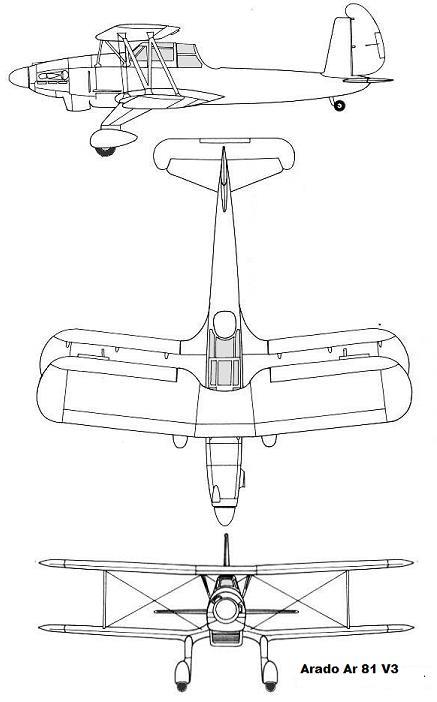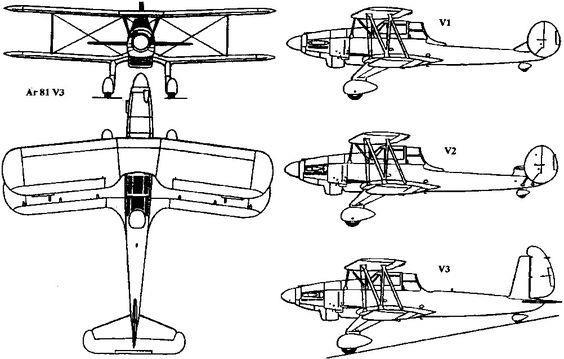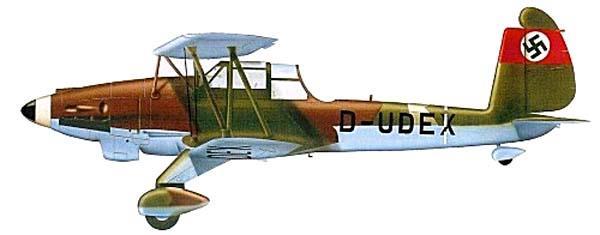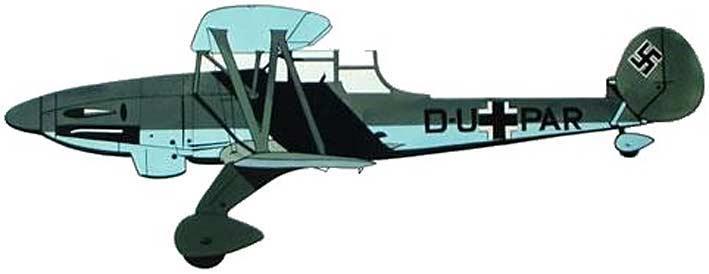In 1934, the Reich Air Ministry or RLM (Reichsluftfahrtministerium) initiated two parallel programmes to build new dive bombers for the German air force, to replace the Heinkel He 50. The first, the so-called Sofort or immediate program, aimed to develop an interim dive bomber, and resulted in the production of the Henschel Hs 123. The second, Sturzbomber program, aimed to produce a more definitive aircraft. In January 1935 the formal requirements for this were sent out to German aircraft manufacturers. These had been written around the Junkers Ju 87, of which the first prototype was already under construction. Indeed the Luftwaffe had already given Junkers an order for 118 aircraft. Nevertheless, two manufacturers received an order to deliver three prototypes of their competing projects: The Heinkel He 118 and the Arado Ar 81. The Blohm & Voss Ha 137 competed as a private venture.
The Ar 81 was the only one of the competitors to be conceived as a biplane. Reportedly this was on the advice of Ernst Udet. There seems to have been some doubt at Arado about the use of this outdated configuration, for alternative designs were made for a monoplane with an inverted gull wing. However, in the end the Ar 81 was built as an all-metal biplane. It was a neat enough design, which looked rather more streamlined than the first prototype of the Ju 87, and was slightly smaller and lighter. The slender fuselage had a closely cowled Junkers Jumo 210C engine up front with a large radiator bath below it. The wings were relatively short in span and connected by N-struts outboard. Behind the wings, the crew of two sat in a roomy cockpit in with a semi-enclosed canopy, back to back. The rear of the cockpit canopy was open to allow the gunner to freely aim his defensive machine gun. The fixed main landing gears legs were fitted with streamlined covers and spats for the wheels.
The tail section was very slender, and the tail of the first prototype, Ar 81V1, consisted of a tailplane with some dihedral that carried two outboard fins and rudders, to improve the field of fire of the tail gunner. However, testing from the end of 1935 onward revealed serious stability problems.[3] The second prototype was given a raised tailplane without dihedral, braced with struts, but this did not cure the issues, and the third prototype had completely reworked tail, with a boom structure of larger cross-section that carried a tall single tail fin and a large rudder. This prototype also had a Jumo 210Ca engine that drove a two-bladed variable-pitch propeller, instead of the three-bladed fixed-pitch unit fitted to the first two prototypes.
The defensive armament of a single fixed MG 17 machine gun, intended to be fitted in the engine cowling, and a MG 15 defensive gun in the rear cockpit, was probably never installed. The same is claimed for the special bomb rack below the fuselage, intended to swing a 250 kg bomb clear of the propeller in a diving attack. However, test pilot Kurt Starck claimed that during the 1936 trials, the Ar 81 was the only aircraft capable of dropping a 500 kg bomb in a vertical dive, which indicates that a bomb rack must have been fitted.
In its developed Ar 81V3 form, the Arado design was in several aspects better than the Ju 87 prototypes, including level speed, manoeuvrability, range, and especially rate of climb: It reached 4000 m in 11 minutes, while the Junkers design needed 23 minutes. However, the Ju 87 was a more modern design and its performance could be improved by installing more powerful engines, while the Ar 81 had less development potential. Due to the delay involved in redesigning the tail, the Ar 81V3 only made its appearance in the spring of 1936, when the RLM had already chosen the Ju 87
| Type |
V1, V2 Two seat dive bomber |
V3 Two seat dive bomber |
| Engine |
1 Junkers Jumo 210B |
1 Junkers Jumo 210Ca |
| Dimensions |
Length 10,50 m, height 3,60 m, span 11,20 m, wing area 35,6 m2 |
Length 11,65 m, height 3,57 m, span 11,20 m, wing area 35,6 m2 |
| Weights |
Empty 2069 kg, flying weight 3198 kg |
Empty weighr 1925 kg, flying weight 3070 kg |
| Performance |
Max. speed 330 km/h , range 790 km, service ceiling 6600 m, climb to 4000 m 11 min. |
Max. speed 345 km/h at4000 m, range 790 km, service ceiling 7700 m, climb to 4000 m 11 min. |
| Armament |
1 forward firing 7,92 mm MG 17 fixed in the engine cowling, 1 flexible 7,92 mmMg 15 in the rear cockpit , 1 × 250 kg bomb on a bomb crutch under the fuselage |
1 forward firing 7,92 mm MG 17 fixed in the engine cowling, 1 flexible 7,92 mmMg 15 in the rear cockpit , 1 × 250 kg bomb on a bomb crutch under the fuselage |
| Type |
Werk.Nr |
Registration |
History |
| V1 |
901 |
D-UJOX |
First flight 19 May 1936 |
| V2 |
902 |
D-UPAR |
First flight in September 1936. From 1937 used at E-Stelle Rechlin as testbed |
| V3 |
903 |
D-UDEX |
First flight in September 1936. From 1937 used at E-Stelle Rechlin as testbed |




